Welcome to our ultimate guide on month-by-month maintenance for thriving avocado orchards! Whether you’re a seasoned avocado grower or just starting, understanding the specific care requirements throughout the year is crucial for achieving year-round success. Avocado trees are unique and demand special attention, and by following a well-planned maintenance schedule, you can ensure healthy trees, optimal fruit production, and, ultimately, a bountiful harvest.
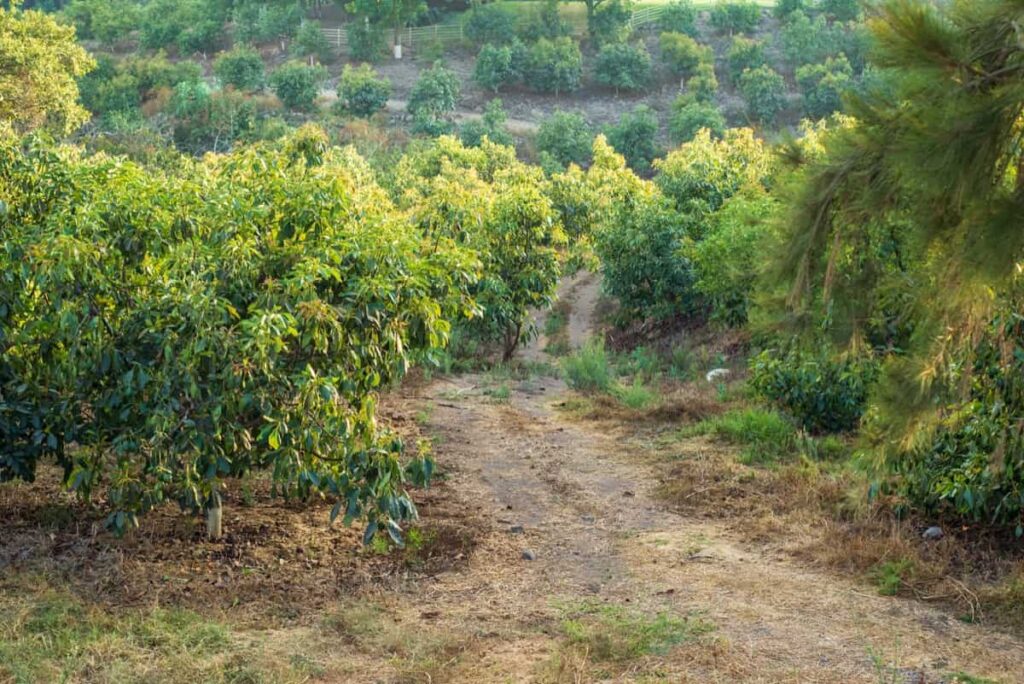
This comprehensive guide will break down the maintenance tasks you should focus on monthly, providing easy-to-follow steps and tips. Get ready to unlock the secrets of avocado orchard maintenance and take your orchard to new heights!
Avocado Orchard Management
What is Avocado Farming and its Overview?
Avocado farming is cultivating avocado trees, scientifically known as Persea Americana. These medium-sized, evergreen trees belong to the laurel family and have been cultivated for over 5,000 years by Mesoamerican tribes who highly valued their large and oily fruits. Originally found in the highlands of south-central Mexico and Guatemala, avocados are now grown in tropical and Mediterranean climates worldwide.
The avocado fruit, sometimes called an alligator or avocado pear, is a large berry with a single seed. When ripe, it has smooth, buttery, golden-green flesh. Depending on the cultivar, the skin color varies from green to brown, purplish, or black. Commercially, avocados are harvested while unripe and ripened later. Due to their nutrient density and high-fat content, avocados are popular in many cuisines and are often consumed to enhance vegetarian diets.
Mexico is the largest global producer of avocados, supplying nearly 30% of the world’s harvest in 2020. However, avocado production can have environmental and social implications. The water demands of avocado farms strain local sources in major production regions, and issues such as deforestation and human rights concerns have been associated with avocado production in Mexico. Climate change poses challenges as global warming alters suitable growing zones and increases the risks of heat waves and drought.
The avocado tree can reach 9 to 20 meters (30 to 66 feet) with 7.62 to 25 centimeters (3 to 10 inches) long leaves. The tree produces panicles of small, inconspicuous flowers with pale-green or greenish-yellow perianth lobes. Each blossom contains nine stamens and has no petals. The fruit of the avocado is a climacteric, single-seeded berry that is pear-shaped and can range from 7 to 20 centimeters (3 to 8 inches) in length, weighing between 100 and 1,000 grams (3.5 to 35.5 ounces). Human selective breeding has resulted in cultivars with larger, fleshier fruits and thinner skins.
In case you missed it: From Seed Selection to Successful Business: Crafting a Comprehensive Avocado Farming Business Plan
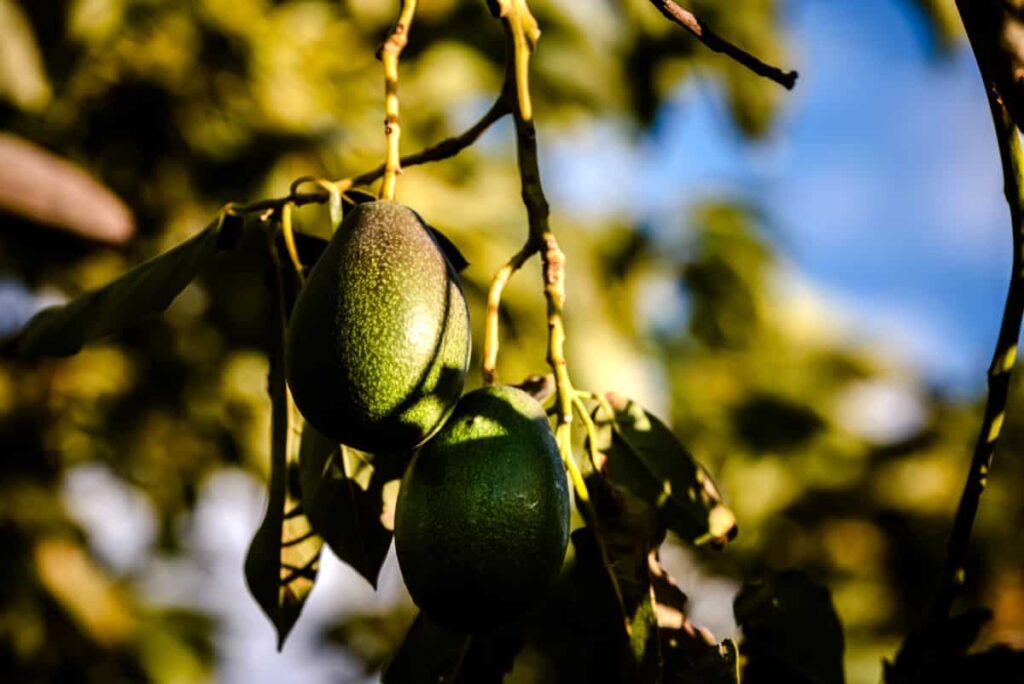
Importance of Month-Wise Planning for Avocado Orchard Maintenance
- Proper month-wise planning ensures that essential maintenance tasks are carried out at the right time.
- It helps optimize tree health, fruit production, and overall orchard productivity.
- Different months require specific activities like pruning, fertilizing, irrigation management, pest control, and harvesting.
- Timely planning minimizes disease risk, pest infestations, and nutrient deficiencies.
- Effective month-wise maintenance leads to consistent quality and quantity of avocados, ensuring profitability for growers.
Best Tips for Growing Avocado Orchard Maintenance Practices
Scientifically known as Persea americana, avocados require a subtropical climate without frost and minimal wind for optimal growth. High winds can reduce humidity, dehydrate flowers, and hinder pollination. Although most avocados are sensitive to frost, the ‘Hass’ cultivar can tolerate temperatures as low as -1 °C. Some cold-hardy varieties in Gainesville, Florida, can withstand temperatures as low as -6.5 °C with minimal leaf damage. Avocado trees thrive in well-aerated soils, preferably deeper than 1 meter.
Climate considerations: Avocados thrive in subtropical climates without frost and excessive winds. High winds can lead to flower dehydration and hinder pollination. While some cold-hardy varieties can tolerate mild frost, choosing suitable cultivars for your specific region is crucial.
Soil requirements: Avocado trees prefer well-aerated soils at least 1 meter deep. Ensure proper drainage to avoid waterlogging, which can harm the roots. Conduct soil tests to assess nutrient levels and pH, making necessary amendments to create an ideal growing environment.
Irrigation management: Avocado trees have moderate water needs, but the requirements vary depending on the location. Avocados generally require approximately 70 liters (18 US gallons) of applied water per fruit, excluding rainfall. However, water needs can differ based on the growing region. Proper irrigation scheduling and techniques help prevent water stress and promote healthy tree development.
Pruning: Regular pruning is essential for avocado orchards. It helps maintain a balanced canopy, enhances sunlight penetration, and facilitates air circulation. Pruning also aids in managing tree height, improving overall orchard access, and promoting better fruit production.
Fertilization: Avocado trees benefit from regular fertilization to ensure they receive essential nutrients for optimal growth. Conduct soil tests to identify nutrient deficiencies and follow recommended fertilization guidelines. Use organic or slow-release fertilizers to avoid excessive nutrient leaching.
Pest and disease management: Avocado trees are susceptible to various pests and diseases. Implement integrated pest management (IPM) strategies to control pests effectively while minimizing environmental impact. Regularly monitor the orchard for signs of pests or diseases and take appropriate measures for prevention and treatment.
Pollination considerations: Avocado trees exhibit dichogamy, meaning their male and female flower phases occur at different times. Understanding your avocado cultivars’ flowering types (A and B) is crucial for proper pollination. Ensure an appropriate mix of compatible cultivars for adequate cross-pollination and fruit set.
In case you missed it: How to Fertilize Avocado Trees For Insane Fruit Set: Schedule for Natural, Organic, and Chemical Application
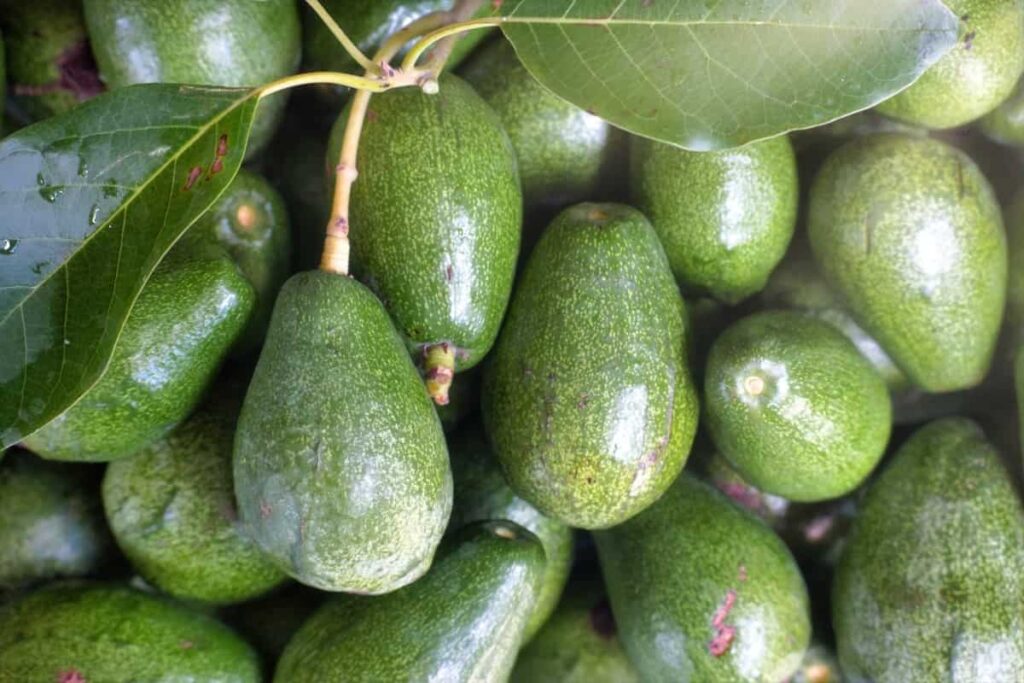
Harvesting practices: Avocados are climacteric fruits, which means they take maturity on the tree but ripen off it. Harvest avocados once they reach maturity, which can be determined by dry matter content or other standards specific to the cultivar. Proper handling during harvest reduces damage and ensures better postharvest quality.
Commercially, avocados are collected while hard and green and stored in coolers at 3.3 to 5.6 °C until they reach their destination. Avocados ripen when mature. Avocados ripen approximately 1–2 weeks at room temperature. Ethylene gas from apples and bananas speeds up avocado ripening. Some stores accelerate ripening with synthetic ethylene. Commercial producers can maximize productivity by leaving avocados on the tree for months.
Postharvest handling: Avocados require careful handling after harvest to maintain quality. Store harvested avocados at cool temperatures (around 3.3 to 5.6 °C) until they reach their destination. Ethylene gas can be used to hasten ripening, but it should be done cautiously and according to industry standards.
Tree spacing and density: Optimal tree spacing and density contribute to efficient orchard management. Consider the growth habits and expected tree size when planning the layout. Sufficient spacing allows for adequate sunlight penetration, airflow, and ease of maintenance operations. Avocado flowering types are categorized as A and B, and their timing differs among cultivars. A-cultivar flowers are open as female on the morning of the first day and male on the afternoon of the second day.
B varieties open as female on the first day’s afternoon and male the following morning. Some cultivars, like ‘Hass,’ tend to bear well only in alternate years, while environmental factors can lead to the appearance of seedless avocados on trees. Advances in cloning techniques have the potential to increase rootstock availability. Preserving the genetic diversity of avocado has relied on field collection, as avocado seeds do not survive well in seed banks. Cryopreservation of avocado somatic embryos has emerged as an alternative conservation method.
January Month Avocado Orchard Maintenance Planning
- Prune trees to shape and remove dead branches.
- Clear weeds around the base and consider mulching.
- Adjust irrigation schedules based on weather and water needs.
- Monitor for pests and diseases, taking necessary control measures.
- Evaluate nutrient requirements and apply a balanced fertilizer.
February Month Avocado Orchard Maintenance Planning
- Water plants at regular intervals of 8 to 10 days.
- Apply Bordeaux Paste on the trunk up to 30 to 45 cm height to prevent termite infestation and fungal diseases.
- Monitor soil moisture levels and adjust irrigation accordingly.
- Inspect trees for signs of pests or diseases and take appropriate action.
- Maintain a clean, weed-free orchard floor to reduce competition for nutrients and water.
In case you missed it: Mastering the Dragon Fruit Orchard Management: A Month-by-Month Operations Guide for Maximum Yield
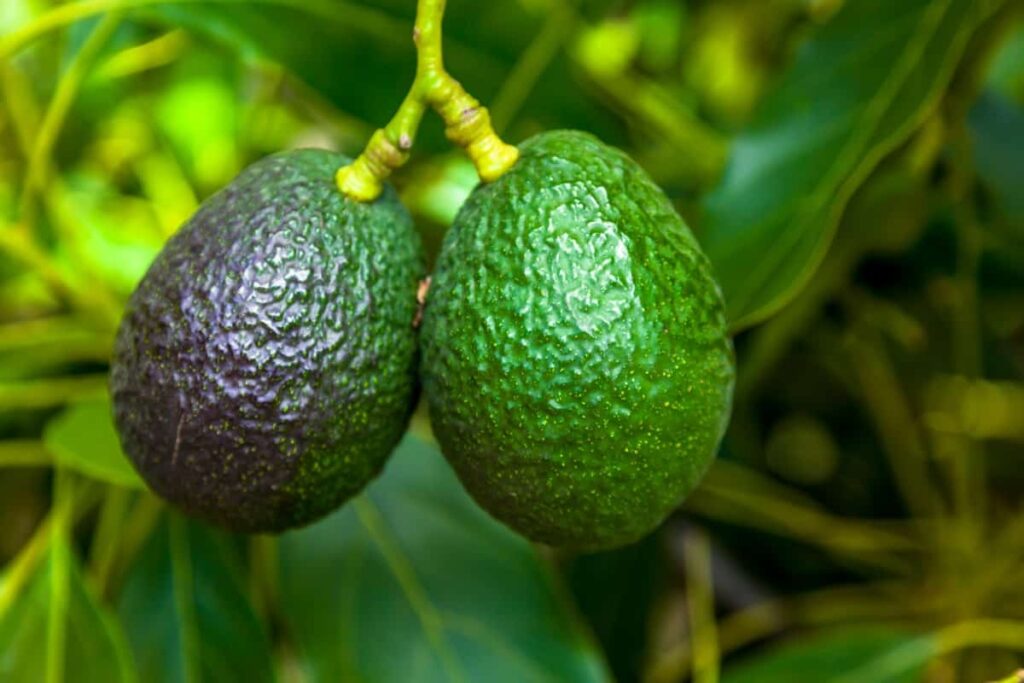
March Month Avocado Orchard Maintenance Planning
- Water plants at regular intervals of 8 to 10 days.
- Apply a basket of dry leaf mulch or paddy straw in basins to control evapotranspiration losses and weed growth.
- Monitor soil moisture levels and adjust irrigation accordingly.
- Conduct pruning activities to remove dead or diseased branches.
April Month Avocado Orchard Maintenance Planning
- Assess soil suitability by digging a profile pit and checking for calcareous nodules or sheet rock. Avoid soils with these characteristics for planting.
- Avoid poorly drained and waterlogged soils.
- Collect soil samples from the profile pit and send them to a soil testing lab for analysis.
- Consider soil pH in the range of 8.0 to 8.5 suitable for avocado plantation, even if it is moderately high.
- Ensure that the subsurface water table in the soil is below 2.5 meters.
May Month Avocado Orchard Maintenance Planning
- The recommend planting avocado trees outdoors in spring to give them time to develop before winter2.
- Harvest to Table recommends planting avocados in containers throughout the season. Plant after the final spring frost and prevent hot, dry weather.
- Conduct a soil assessment by digging a profile pit to identify calcareous nodules or sheet rock. Avoid soils with these characteristics for avocado planting.
- Avoid poorly drained and waterlogged soils, as they can negatively affect the health and growth of avocado trees.
- Collect soil samples from the profile pit and send them to a soil testing lab for analysis. This will provide valuable information about the soil’s nutrient content and pH levels.
- Consider a soil pH range of 8.0 to 8.5 suitable for avocado plantation, even if it is moderately high.
- Ensure that the subsurface water table in the soil remains below 2.5 meters to prevent waterlogging and root damage. Proper drainage is essential for avocado trees’ health and productivity.
June Month Avocado Orchard Maintenance Planning
- Fill the pits with a mixture of topsoil, 50 kg Farm Yard Manure (FYM), 1 kg Single Super Phosphate, 1 kg Neem Cake, and 100 gm of 10% Follidol dust per pit.
- Ensure that the pits are filled with soil at least 12-15cm above the ground level, allowing settling to reach ground level during planting.
- Establish thorn fencing or a thick live fence to prevent cattle trespassing and protect the avocado orchard.
- Mark out the trench for drip irrigation installation and complete the trench-cutting process.
- With the onset of the monsoon, consider sowing intercrops in the orchard. Suitable intercrops for avocados can include nitrogen-fixing legumes like beans or peas or leafy greens like lettuce and spinach, providing temporary ground cover and additional income opportunities for farmers.
In case you missed it: Optimizing Fig/Anjeer Orchard Management: A Month-by-Month Operation Guide for Maximum Yield
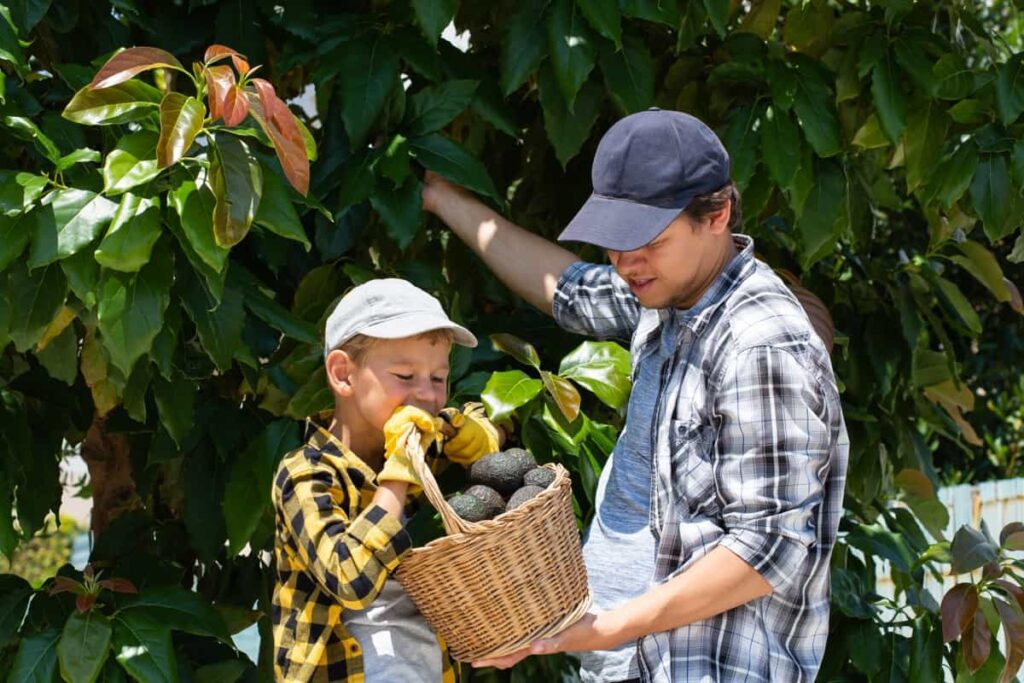
July Month Avocado Orchard Maintenance Planning
- Procure high-quality plant material, specifically vineer grafts, to minimize future losses.
- Select grafts at least one year old, with 4 to 6 flushes and a 50 to 75 cm height.
- Ensure the graft union is perfect and at least 15cm above the soil in the poly bag.
- Choose healthy saplings without pests, diseases, or side shoots on the rootstock.
- Arrange for transportation of the plants from the nursery to the planting site.
- Keep the saplings near a water source and water them regularly until planting.
- If rainfall is delayed, irrigate the pits or run the drip system to ensure adequate moisture.
- Carefully remove the polythene sheet from the graft union and plant the sapling in the center of the pit, keeping the graft union 6 inches above ground level.
- Stake the plant with a strong support stick, treated with black tar to deter termite attacks.
- Water the plant immediately after planting and irrigate at intervals of 7 to 10 days.
August Month Avocado Orchard Maintenance Planning
- The avocado plant’s growth is slow but hardy, with new flushes appearing in 4 to 6 weeks. Protect the new growth from leaf-eating caterpillars or leaf webbers by spraying Quinolphos or Endosulphon at a rate of 2 ml per liter of water once a month.
- Weed the orchard at least once every two months during the monsoon season to control weed growth.
- Plough the inter-spaces using a blade-harrow or cultivator to keep the land weed-free.
- Mulch the basins with paddy husk, straw, or groundnut shells to reduce evapotranspiration losses and control weeds.
- Remove any side shoots that appear on the rootstock.
- Failure to control the disease may result in twig drying (Dieback) and eventual plant death.
September Month Avocado Orchard Maintenance Planning
- If termite attacks are observed on the support stick, spray Chloropyriphos (Termex-C) at a rate of 5 ml per liter of water on the stem and support stick. Drench the basins with the same chemical.
- Prune side branches that emerge from the main trunk at ground level to maintain a clean and well-shaped tree structure.
October Month Avocado Orchard Maintenance Planning
- Fill any gaps in the orchard caused by plant death by replanting in those areas.
- Remove any side shoots that appear on the root stock.
- In regions with high rainfall, planting can be done in October-November.
- Farmers can sow intercrops for the rabi season in October if intercropping is not done during June-July.
- Apply approximately 100 grams of DAP (Di-ammonium phosphate) in the basins and irrigate immediately.
In case you missed it: Optimizing Coconut Orchard Operations: A Comprehensive Management Guide for Month-wise Planning
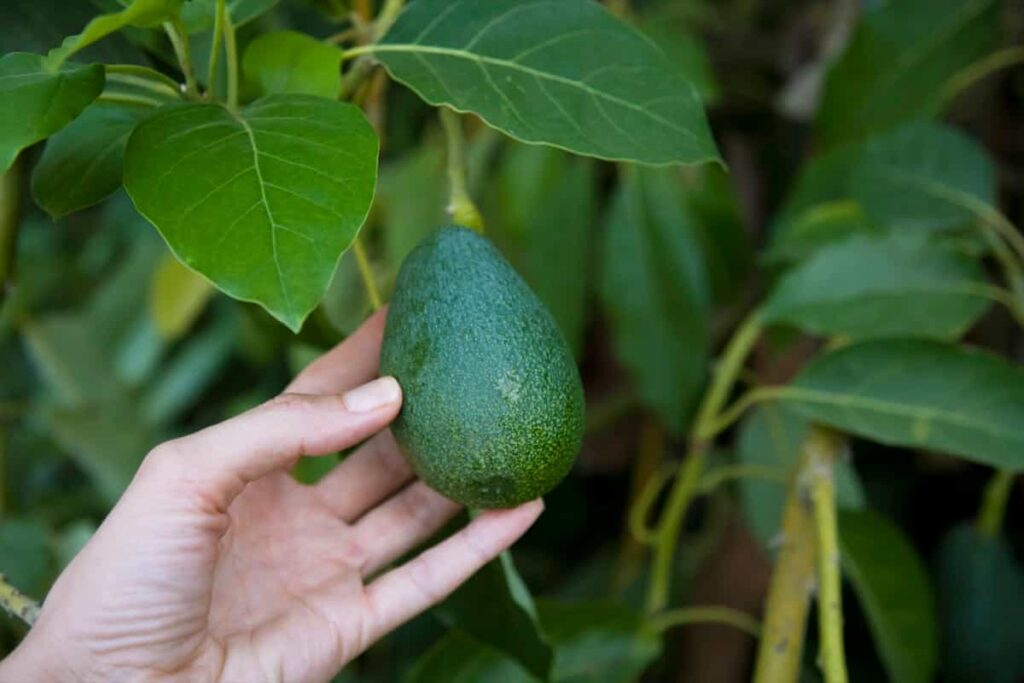
November Month Avocado Orchard Maintenance Planning
- Work the soil in the basins and mulch with dry leaves or paddy straw to control evapotranspiration losses and weed growth.
- Remove any side shoots that appear on the root stock.
- Regularly water the plants at 8 to 10 days intervals to ensure proper hydration and growth.
December Month Avocado Orchard Maintenance Planning
- Prune the trees to remove dead or damaged branches.
- Inspect and repair the irrigation system if needed.
- Apply organic mulch around the trees to conserve moisture and suppress weed growth.
Conclusion
Ultimate Guide provides a month-by-month maintenance plan for successful avocado orchards. Following the suggested tasks, including watering, soil assessment, pest control, and pruning, orchard owners can ensure optimal conditions for healthy avocado trees and maximize their harvest yields.
- Sheep Farming Business Plan for Beginners
- Aquaponic Farming at Home: A Step-By-Step Guide
- Profitable Village Farming Business Ideas in 2024
- High-Yield Aquaculture: Fast-Growing Fish for Farming
- Effective Fish Pond Construction Techniques for Beginners
- Irrigation and Water Management in Pineapple Farming
- Blossom to Harvest: Mastering Flowering and Pollination in Papaya Farming
- Pig Fattening Essentials: From Selection to Sale for Beginners
- Raising Wagyu Cattle: A Complete Guide for Premium Beef Production
- Soil Types and Their Water Holding Capacity
- Optimizing Irrigation Schedules for Coconut Groves for Enhanced Yield
- Espresso Your Garden: Coffee Grounds for Healthier Acid-Loving Plants
- The Best Soil Mix for Snake Plants: How to Mix Your Own Snake Plant Soil
- Green Thumb Success: Expert Tips for Cultivating Greenhouse Beans All Year Round
- Bloom All Year Round: The Ultimate Guide to Indoor Hyacinth Care
- Eco-Friendly Gardening: How to Make Liquid Fertilizer from Kitchen Waste
- Ultimate Guide to Grow Anise in Pots: Explore Seed Propagation to Harvesting
- Guide to Raising Chester White Pigs: Discover Breed Facts to Growth Management
- Mastering the Elegance: The Ultimate Guide to Weeping Cherry Tree Care, Planting, and Maintenance
- Ultimate Guide to Planting Garlic in Grow Bags: Growing Strategies for Beginners
- How to Fix Spider Plant Leaf-Related Problems: Natural and Organic Remedies
- 10 Reasons Why Your Tulsi Plant is Shedding Leaves: Home Remedies and Solutions
- Optimizing Growth and Yield: The Advantages of Palm Bunch Ash Fertilizer
- Utilizing Neem Oil Extract as a Natural Pesticide for Hydrangea
- From Soil to Harvest: Various Ways in Which Farmers Can Use AI Tools
- Steps to Encourage and Induce Citrus Flowers: A Comprehensive Guide
- How to Fix Snake Plant Leaf-Related Issues: Natural and Organic Remedies
- Transform Your Garden into a Fragrant Oasis with Raat Ki Rani (Night Blooming Jasmine)
- Discover the Ideal Chicken Breeds for Philippine Farms
- How to Create a Poultry Egg Farm Business Plan for Profits
- Grow Lemon Cucumbers Like a Pro: Insider Techniques for Bountiful Yields
- Ultimate Guide to Caring for Your Pink Princess Philodendron: Tips for Thriving Variegation
- Areca Nut Profit Per Acre: Calculating Yield and Cost of Cultivation
- How Kaveri Chicken is Becoming a More Profitable Breed in Indian Backyards
- Transform Your Barn: 9 Steps to Convert a Horse Stall into a Chicken Coop
- Exploring Suffolk Sheep Disadvantages with Limitations and Challenges
